Tender beef, coated in a thick and smooth gravy, served with homemade Austrian-style pasta. Doesn’t that sound like the best comfort food ever? Yes it does, and yes it is! Austrian beef goulash (Rindsgulasch) is one of my most favorite dishes.
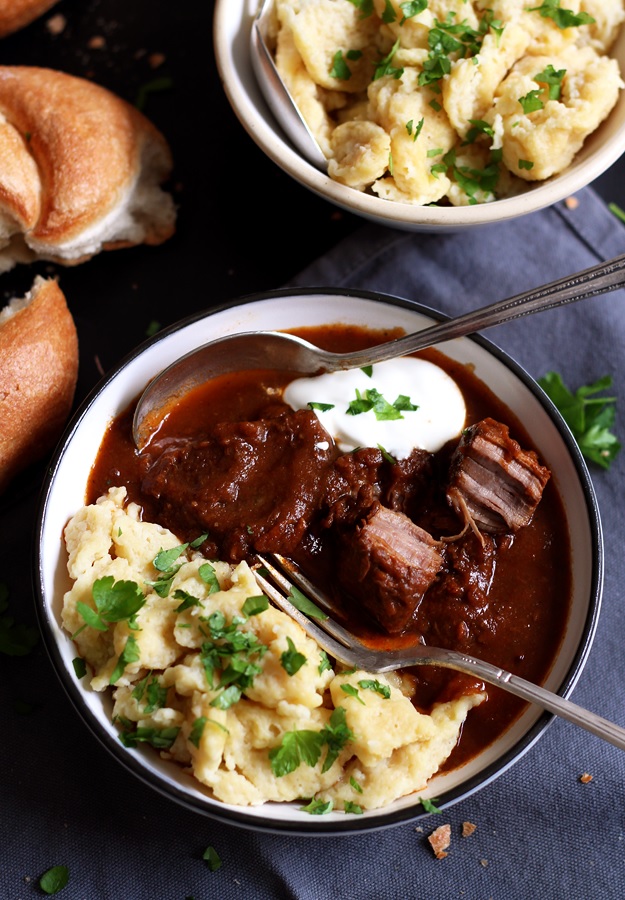
When we lived in Boston and went to Austria for holidays, my mom would ask me if I’d have any cravings for Austrian food and what she could cook for me. The answer was always the same: Beef goulash. There is just something about this dish that makes it so special and comforting. Unlike what most people think, beef goulash is easy to make, it just needs time.
As you may have noticed from browsing the recipe index on this site, I am not really much into eating meat. I only eat meat occasionally. However, when it comes to an authentic Austrian beef goulash, I never say no.
I particularly enjoy it when served with a pile of homemade Austrian-style pasta like Spaetzle (recipe here, simply omit the caramelized onions) or homemade Nockerl that you can see in the pictures. They are similar to Italian gnocchi, but much easier and quicker to make from scratch (recipe here). I am a huge carbs person, so I am equally looking forward to the handmade pasta as to the goulash itself ;-)
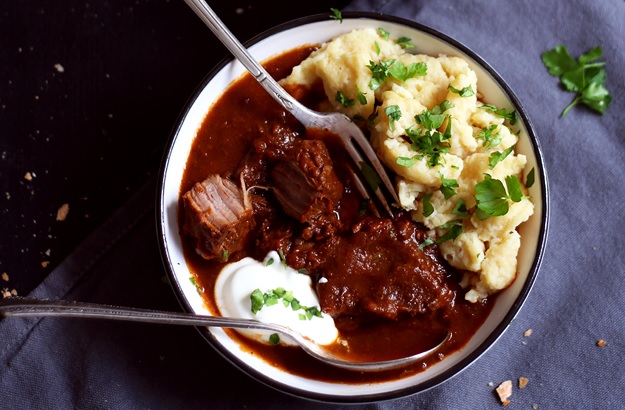
Difference Hungarian and Austrian goulash
Austrian beef goulash is not comparable to Hungarian goulash. It may have derived from Hungary, but it evolved into a completely different dish today. Authentic Austrian beef goulash is also known as “Wiener Saftgulasch” which translates to something like “Viennese gravy goulash”, highlighting the thick gravy base.
Whereas Hungarian-style goulash like gulyás or pörkölt is often soupy and contains bell peppers or potatoes, the Viennese-style goulash only contains beef and onions.
The Austrian beef goulash consists of tender beef that is coated in a thick, dark, and smooth gravy, made without any thickening agents like flour, roux, or sour cream. It thickens naturally over time with the help of dissolving onions and collagen-rich beef.
Which cuts for beef goulash
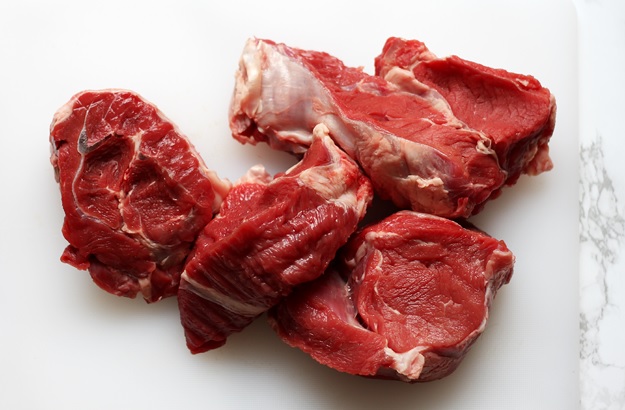
The key is to use tough cuts of beef that you would usually use for stews – with plenty of collagen and fat. If you cook this kind of meet low and slow, the collagen will transform into gelatin, making the meat tender and the gravy thick and rich. That’s the secret. Austrians traditionally use cuts from the shank (‘Wadschinken’), but if it is not easily available, you can use cuck (beef shoulder) or short rib as well.
The only thing you have to keep in mind is to use cuts with fat and connective tissue (collagen), usually from either the front shoulder or the rear end. This website provides an overview of the different cuts of beef, which I consider very helpful. Also, there is a summery for the best cuts used in stews on serious eats.
The picture above shows 2 1/4 lbs (1 kg) of beef. I bought it at a supermarket in Vienna, pre-packed and cut into 4 parts. Since goulash is such a favorite among Austrians, the package only said “goulash beef”, but didn’t specify from which part of the cow the meat came from. I would guess shank, since this is the traditional cut to use for goulash. It could have also been a cut from the chuck (shoulder) though.
Reheating enhances Goulash
There is a saying in Austria that roughly translates to something like „Reheating only works for goulash.” (“Aufgewärmt ist nur ein Gulasch gut.”) You will hear this saying when somebody considers getting back together with an ex (“reheating” the relationship) is a bad idea. I always have to smile when I hear this saying. It’s so typical Austrian, classic Viennese grumpy style.
Prepare the goulash at least one day in advance, preparing it two days ahead would be even better to enhance the flavors, to thicken the gravy and tenderize the beef even further. Reheat the goulash once a day, other than that, store it in the refrigerator.
Enjoy with a fresh and crunchy Kaiser roll and some homemade spaetzle. Find the recipe plus a 1-minute video for the ‘Nockerl’ in the pictures here. They taste kind of like spaetzle but their texture is a bit firmer and they are larger, similar to Italian gnocchi. I simply love Nockerl as a (very traditional) side dish for goulash – and they are super easy to make from scratch at home.
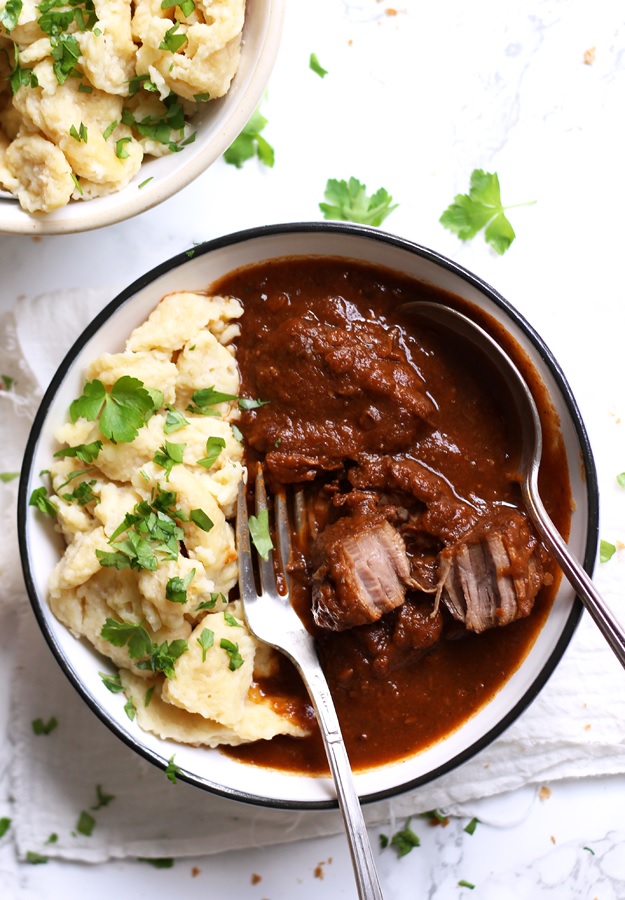
Step-by-step recipe for authentic Austrian beef goulash
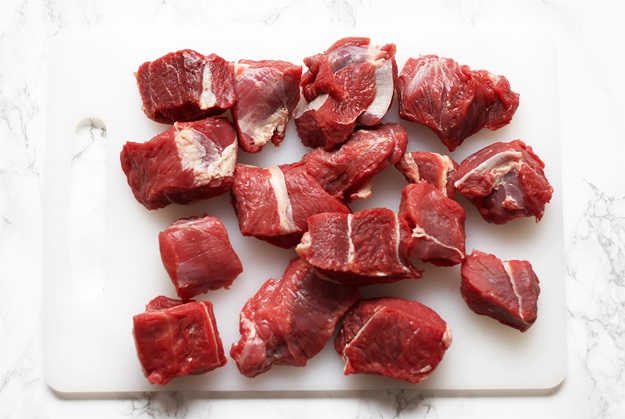
Cut beef into 2-inch (5-6 cm) cubes. Only trim off thick outside fat, in case there is any. I hardly trimmed off anything here. The interior fat will be rendered out during cooking which makes the beef tender and the sauce smooth and thick. Find details above for which cuts to use.
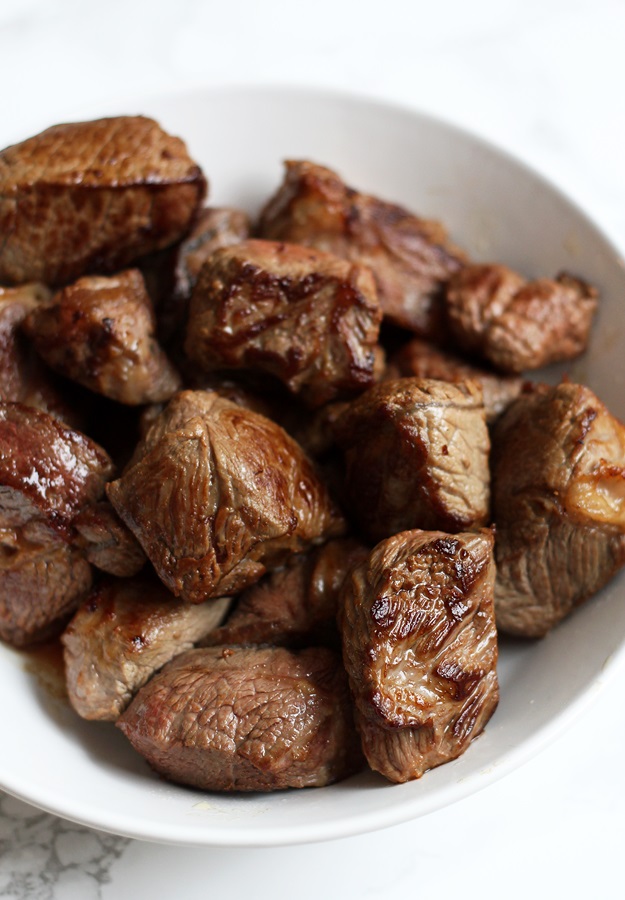
Heat 1 tablespoon clarified butter or oil in large pot over medium-high heat. Add beef and sear, turning occasionally, until beef is browned, about 5-10 minutes. The pot shouldn’t be crowded or the meat won’t brown nicely. Rather add beef in two batches. Add more oil if needed. Transfer beef to a large plate and set aside.
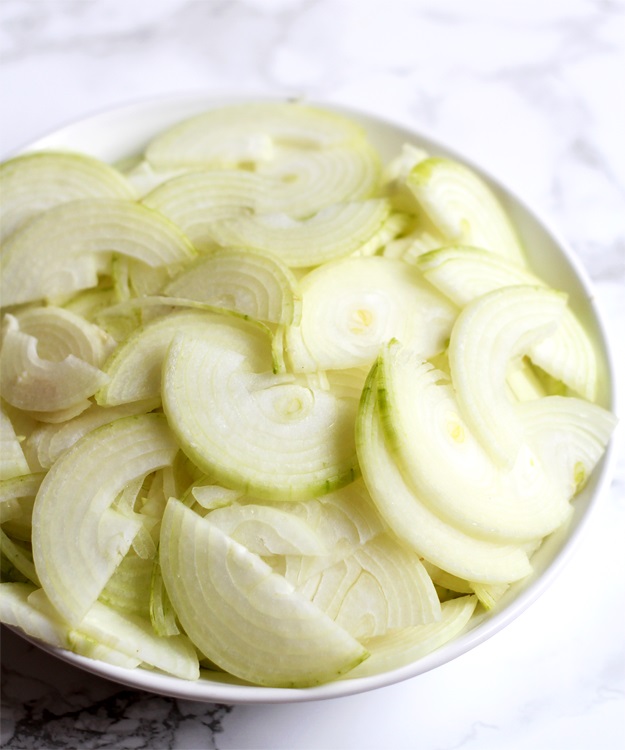
Peel onions and cut them in half, lengthwise. Cut into thin and even half-moon slices to ensure they all cook evenly later.
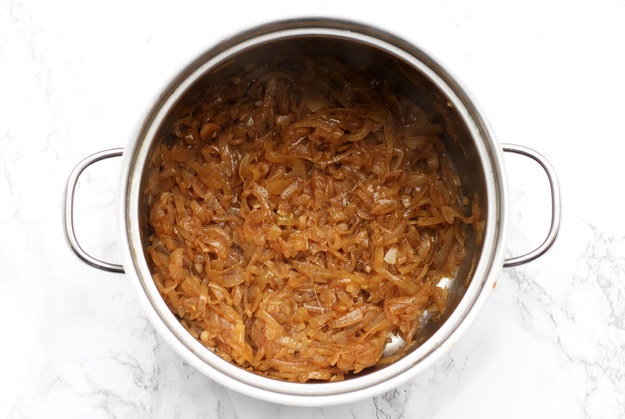
Add a tablespoon clarified butter or oil and the sliced onions to the pot. Cook for 8-10 minutes over high heat, stirring steadily. Reduce heat to medium-low and cook until the onions are golden brown and soft, stirring often, about 15 additional minutes. They will lose a lot of volume.
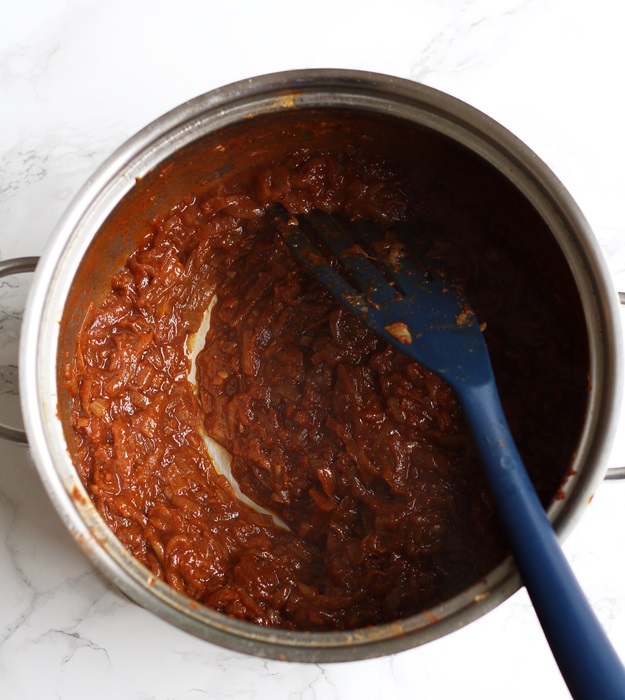
Add tomato paste, marjoram, caraway seeds (I always mince them, see step 5 in the recipe part below), and paprika to the onions. Stir for about 20 seconds. Do not sauté longer since paprika will get bitter if cooked for too long. To be on the safe side, you can add all the spices except paprika. Sauté them for ½ to 1 minute.
Now add paprika and stir for a few seconds. Immediately add vinegar, followed by a cup (240 ml) of water. Stir well and let the onion-mix reduce until almost all liquids have evaporated, about 15 minutes (see photo above).
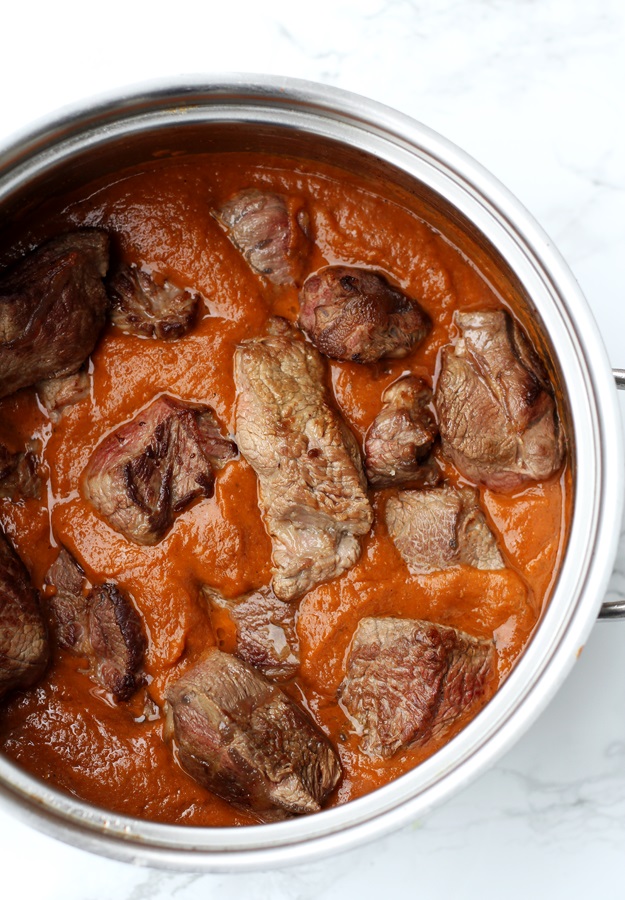
Add another cup of cold water (for easier blending) and blend using an (immersion) blender, then return to pot. The sauce will be orange but will darken the longer it cooks.
Add salt, bay leaves, and beef with any accumulated juices to the pot. Stir to combine, cover with a lid, and return to a simmer over low heat. Only if the beef cooks low and slow it will get tender. This will take about 3 hours.
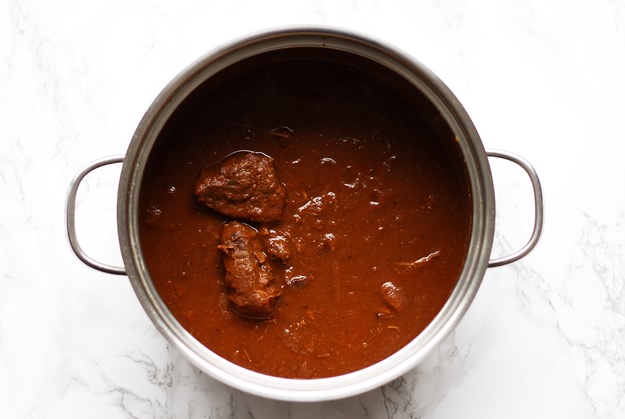
After about 3 hours of braising: The meat is tender, the sauce is darker in color and thickened slightly. Season to taste with salt (you will probably have to add a pinch or two).
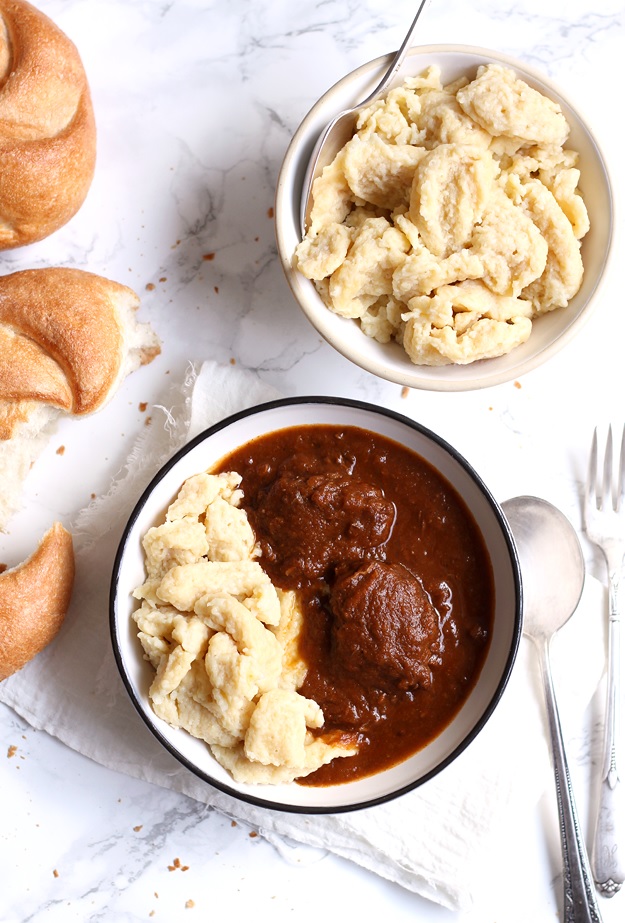
In theory, the goulash is ready now. However, I highly suggest letting it cool overnight (put it in the fridge, lid on) and reheating the goulash the following day. This will enhance the flavor and texture.
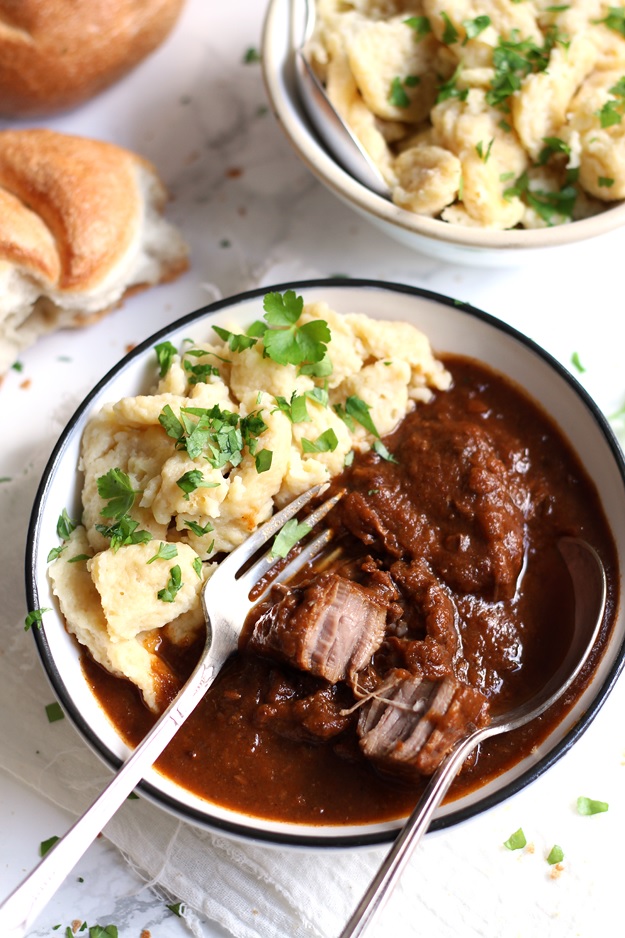
You can reheat it over the next couple of days, the goulash will only get better. Add a little water to thin, if needed. Store in the fridge in between.
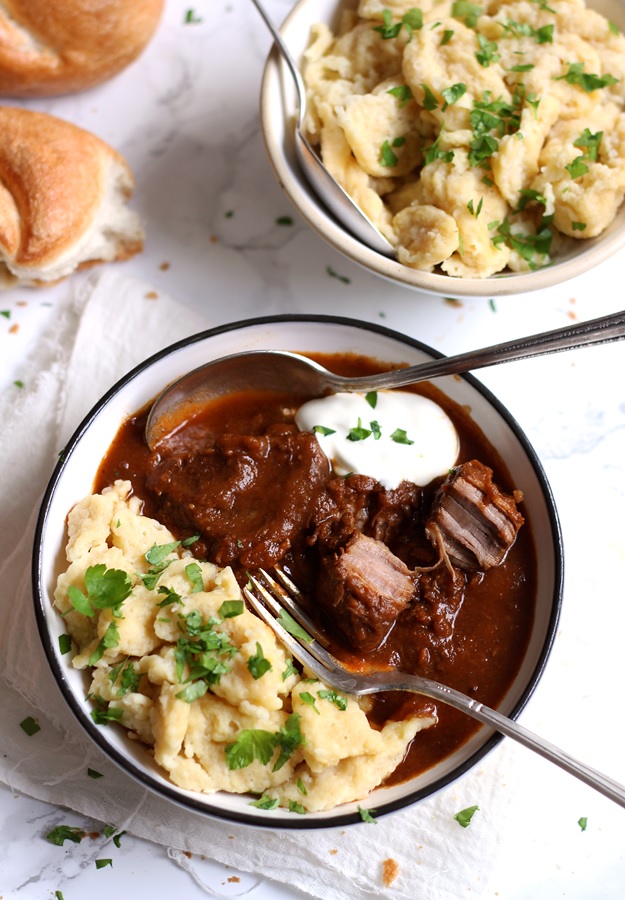
Serve with a crunchy Kaiser roll and Austrian-style pasta like Spaetzle or Nockerl.
Enjoy!
If you are on the lookout for a different kind of goulash, try this Creamy Austrian potato goulash or my traditional vegan potato goulash. In general, there are two kinds of goulash in Austria: One is beef goulash, the other one is potato goulash (picture below).
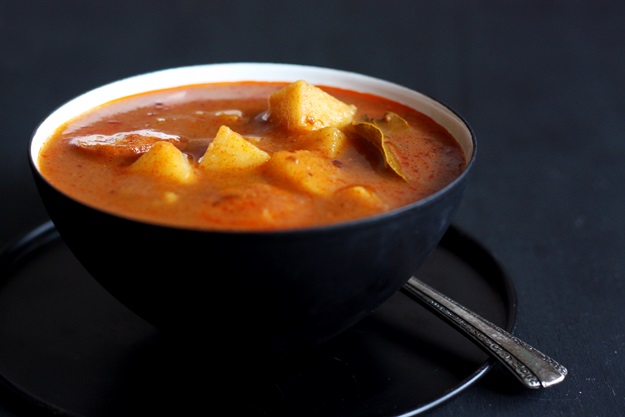
There are 2 recipe for potato goulash on the blog: The first recipe contains sausage (see photo above), the other one is a naturally vegan potato goulash.
Authentic Austrian Beef Goulash
Ingredients
- 2 1/4 lbs (1 kg) whole boneless beef shank (if not available, use shoulder/chuck roast or short rib)
- 1 3/4 lbs (800 g) yellow onions
- 1/2 tablespoon dried marjoram
- 1/2 tablespoon caraway seeds or ground caraway seeds (do not substitute cumin), see step 5
- 1 tablespoon (20 g) tomato paste
- 4 tablespoons (30 g) sweet Hungarian paprika powder (if not available, use mild paprika powder)
- 1 teaspoon hot paprika or a pinch cayenne pepper (optional)
- 1/2 tablespoon vinegar (any will do)
- 3/4 teaspoon fine salt
- 2 bay leaves (optional)
- Clarified butter or vegetable oil
In addition:
- Large pot with lid
- Perfect side dishes: Kaiser rolls, bread, Spaetzle, or Nockerl (Spaetzle recipe, Nockerl recipe)
Instructions
- Cut beef into 2-inch (5-6 cm) cubes. Only trim off thick outside fat, in case there is any. The interior fat will be rendered out during cooking which makes the beef tender and the sauce smooth and thick.
- Peel onions and cut them in half, lengthwise. Cut into thin and even half-moon slices to ensure they all cook evenly later.
- Heat 1 tablespoon clarified butter or oil in large pot over medium-high heat. Add beef and sear, turning occasionally, until beef is browned, about 5-10 minutes. The pot shouldn’t be crowded or the meat won’t brown nicely. Rather add beef in two batches. Add more oil if needed. Transfer beef to a large plate and set aside.
- Add a tablespoon clarified butter or oil and the sliced onions to the pot. Cook for 8-10 minutes over high heat, stirring steadily. Reduce heat to medium-low and cook until the onions are golden brown and soft, stirring often, approximately 15 additional minutes.
- Note: This step is optional and buying ground caraway seeds is easiest. You can add marjoram and caraway seeds as is (almost all recipes do so). I, on the other hand, always mince marjoram and caraway seeds to transform them into powder (or at least chop finely). Mince the marjoram with a sharp knife until powdery. This works very well and you’ll be finished within 30 seconds. Now the trickier part: Usually, caraway seeds tend to be too firm to crush with a mortar and pestle. Either, grind caraway seeds with an electric grinder (coffee grinder), or chop them with a knife. I usually sprinkle the seeds onto a dollop of softened (clarified) butter and mince them with a sharp knife. The butter prevents the caraway seeds to jump off the cutting board. Add the seeds including the (clarified) butter during the next step.
- Add tomato paste, marjoram, caraway seeds, and paprika to the onions. Stir for about 20 seconds. Do not sauté longer since paprika will get bitter if cooked for too long. To be on the safe side, you can add all the spices except paprika. Sauté them for ½ to 1 minute. Now add paprika and stir for only a few seconds.
- Immediately add vinegar, followed by a cup (240 ml) of water. Stir well and let the onion-mix reduce until almost all liquids have evaporated, about 15 minutes.
- Add another cup of cold water (for easier blending) and blend using an (immersion) blender, then return to pot. The sauce will be orange but will darken the longer it cooks.
- Add salt, bay leaves, and beef with any accumulated juices to the pot. Stir to combine, cover with a lid, and return to a simmer over low heat. Only if the beef cooks low and slow it will get tender. This will take about 3 hours. The sauce will get darker in color and it will thicken slightly. Season to taste with salt (you will probably have to add a pinch or two).
- In theory, the goulash is ready now. However, I highly suggest letting it cool overnight (put it in the fridge, lid on) and reheating the goulash the following day. This will enhance the flavor and texture. You can reheat it over the next couple of days, the goulash will only get better. Add a little water to thin, if needed. Store in the fridge in between.
Notes
Did you follow this recipe? You could share your result here. All you need to do is take a picture with your smartphone and send it to [email protected]Dewan: My version of goulash. Thank you. Enjoyable! Click to enlarge.
Michael: The goulash was a big hit!!! No leftovers ;-) Click to enlarge.
The Swan family: Thank you for the delicious recepie. We have traveled all over the world from being stationed in Italy for 4 years. Preparing this dish, with the aromas and then the flavor was like being pulled back into the Austrian countryside, where we stopped and walked into a little cottage to eat for the first time. We paired it with a delicious spatzle and spinatknodel. Click to enlarge.
Momir: Hi, this is one of the best gulasch recipes ever :) It instantly became top dish for winter time :) Click to enlarge.
Mihaela: I am Mihaela a Romanian in Austria trying to make Austrian Goulash :). Thank you !!!! this is the best recipe till now and came out good . Kind regards Mihaela T. Click to enlarge.
Amanda: Goulash - very delish! Click to enlarge.
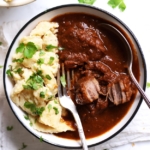
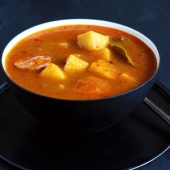
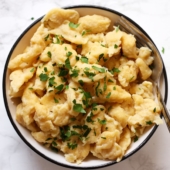
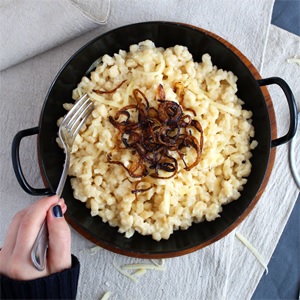
I copied and pasted and printed out this recipe.. Looks so good. I will post a picture when I make this yummy looking authentic Austrian beef goulash. I am making it for my sons birthday along with Spaetzl.
Hi Kim,
Great to hear that! I hope it turns (or turned) out well! I love this dish on a rainy or cold day, it’s so comforting. Even more with homemade paste, be it spätzle or homemade nockerl :-)
Ursula, I was skiing in Kitzbuhel in 1978 (very dating I know) I had this goulash and loved it but have never had it since. Always wind up with the Hungarian versions which is not the same. I add beef to mine but also add small whole brown mushrooms for variety and reduce the meat. Thanks so much.
Great to hear, Howard. Nope, Hungarian and Austrian goulash are definitely not the same as you’ve noticed. Love the addition of mushrooms! Thanks so much for your comment :-)
Want to try this receipe, but would like to transfer it to the oven. Would you be able to suggest a cooking time?.
Hi Catherine,
If you want to cook it in the oven I’d use 150°C/300°F for about 2,5 hours, covered. The meat should be tender – if not, let cook for another 1/2 hour. Check every now and then if there is enough liquid left. Hope that you’ll try it some day, Ursula
LEGIT! Been looking for the perfect recipe for years. Thank you so much!!!
Great to hear that you are a fan of my goulash! You are very welcome :-)
Oh, hey… I always make a double batch and the browning of the onions part… That always takes me about 2 hours. 15 minutes and they’re barely golden. Are you doing something special to get it done in 15 mins or maybe a typo? I know I’m making a double batch, but still… pretty large gap between us. Thanks again!!! This wonderful and about to be Christmas Dinner! :)
Hi Brian,
So happy to hear that you like the recipe. The onion browning part depends largely on the pot/pan you are using and on how thin the onions are sliced. I have never made a double batch (as far as I can remember) but it shouldn’t take that long. A larger pot, in which a larger portion of the onions have contact with the bottom of the pot at the same time, is preferred. Use the largest pot possible. For me, it takes about 25 minutes get the browning that you can see in the photo above. The 15 minutes in the recipe are in addition to the first 10 minutes. But I have to admit, I crank up the heat to maximum while constantly stirring for the first 8-10 minutes. After that, I reduce the heat a little and keep stirring often. After about 25 minutes, I have the desired browning. I’ll add an ‘additional’ before the 15 minutes, so that it is clearer. Thanks for your comment!! I hope that you’ll make it again soon. In Austria, goualsh is a traditional dish for New Years Eve – best if made the day before and simply reheated on the 31st. Wishing you the best for the new year, Brian! Ursula
Fabelhaft! So wie ich es drüben zubereitet habe. Habe Sie es jemals mit Gurkensaft probiert?
Gurkensaft as in pickle juice or cucumber juice? Nein, noch nie probiert. Ein Versuch wert?
Dill pickle juice.. I get a brand are pickles called Hengstenberg, imported from Germany at Big Lots. But it is a practice I first heard of in Salzburg, so I think it’s authentic. I like it anyway. In fact I had some this evening.
Ah ok. Never heard of this practise but it sounds authentic to me too.
Hi Ursula, it’s quite hard to get Hungarian Paprika (powder) in my country. Is there something I can substitute it with or is there an alternative?
Hi Jeanine,
You can substitute any paprika powder that doesn’t taste too hot. Hungarian Paprika tastes mild. Hope you’ll find something like that. Best, Ursula
I made this for the third or fourth time this evening, this time using a mix of lamb and beef chuck (it’s currently in the refrigerator as yes, it tastes much better the next day). This recipe is, by far, my favorite goulash recipe. I studied abroad in Vienna for 9 months when I was in my early 20s and came to love goulash. The one piece of critical feedback that I have is that, given that you’re simmering the soup for three hours, I haven’t found a need to blend the onions before adding the beef. They more or less disintegrate on their own. Either way, thank you so much for this recipe. I’ve sung its praises to friends of mine who have spent time but don’t currently live in Vienna.
Hi Adam,
So happy that you like the recipe :-) Even better when the onions kind of dissolve – my mom never blends the goulash either. I usually do since i love it when the sauce is very thick and super smooth. Hope you will make it again and again and again. And thanks so much for the praises. All the best for 2020, Ursula
Hello Ursula,
I made this goulash version with Nockerl this past weekend. The goulash was amazing! I will definitely make it again.
I also made the apple strudel because a good strudel is amazing with coffee. But since it’s hard to find around here (Toronto) these days, I felt I needed to make it myself. It tasted great but I have to work on the dough to get it as thin as you instructed.
Thanks so much for sharing all these Austrian recipes. I look forward to exploring your website further. My next recipe will be the Kaiserschmarrn. :-)
Kind regards,
Arne
Hi Arne,
So happy to hear that you made the goulash, nockerl and apple strudel. Wow! Stretching the strudel dough is a little tricky in the beginning but will get better every time you do so. If the dough isn’t stretched really, really thin, the strudel crust may be a little hard ;)
Hope you’ll finde some more recipes here to try. All the best, Ursula
I will be attempting this tomorrow. I originally thought goulash was an Austrian cuisine. I’m really ignorant on where food came from. I think I love goulash with pasta the most because that’s how my dad use to cook it. My dad is Austrian and use to make goulash a lot for me and my sister. Hopefully, I don’t mess it all up!
Hi Anna,
I hope you tried and liked it. Pasta is always a good choice! Well, Austrians will tell you that goulash is Austrian cuisine ;-) And since our grandmothers and their ancestors have been making it already, it is considered Austrian. Also: The hungarian version is made differently. So here you go :)
I just made this and it’s a desaster. The sauce only darkened marginally (to a light brown) and the meat is tough and dry. I used boneless beef shin and followed every step of the recipe very carefully. Any idea where I might have gone wrong? If everyone else has had success with this recipe, I assume I must have messed up somewhere along the way to not have the same result.
Hello Sabine,
I’m so sorry to hear that. I know how frustrating this is :(
I can only make some guesses, based on the information I have got here. So here are my tips:
1. Sauce did not darken enough:
The sauce gets its color from the browned onions, paprika and tomato paste. Make sure that you sauté the onions until golden brown (like in the picture). So far, all different kinds of paprika worked for me, so just make sure to use 4 tablespoons – even if this sounds a lot. Usually, all tomato pastes are basically the same, just make sure not to use tomato puree but the concentrated tomato paste. After adding all these ingredients, the sauce is pretty dark in color already. If it is not, it must be some of the things I’ve mentioned above. Or try a different brand of paprika. If I blend the mixture, it will get somehow lighter in color but during cooking gets back to a dark orange or brownish color.
2. The meat is tough and dry:
Beef shin should work fine. Read here: https://www.greatbritishchefs.com/how-to-cook/how-to-cook-beef-shin Since the cuts can vary in moisture, make sure there is connective tissues and that it is not lean. Chuck or short rib work fine too. The most important thing is to cook the meat low and slow. Make sure that it barely simmers on the stovetop. You could also use a slowcooker or dutch oven and cook it at low temperatur in the oven.
I hope that you will try it again some time – maybe switch some things like the cut of beef or brand of paprika. I know that this is a time-consuming recipe but it tastes really delicious. Ursula
I’ve lived in Vienna for 8 years, and I was really missing he flavour of wienergoulasch, I made your recipe and it’s delicious. I just used a slow cooker instead and left it over night. Great recipe, thank you!
Hi Ananda,
Thanks! Goulash is perfect for a slow cooker ;-) I’m glad that this recipe could bring back a bit of Vienna to you :)
I had tried several different recipes but stopped searching after I tried this one. It has been my go to for the last year and a half, so figured I should get around to saying thank you. It tastes like what my grandfather made and what I remember from the train station in Graz (of all places) and a Gausthaus in Sinabelkirchen. Awesome recipe. Thank you.
Hi Karl,
So happy to hear that. You made my day :) Thank you so much for your comment. I hope you’ll make it again and again. Ursula
I had an amazing Austrian nanny for my son back in 1980. This is almost identical to her recipe which I have been using ever since. It’s really excellent. Thanks. 🇨🇦
Hi Anne,
Happy to hear that! Sounds like your nanny had an amazing recipe ;-)
I followed the recipe precisely. I only had balsamic vinegar so that is what I used. It was very easy to make & turned out great! I am making this my new, go-to goulash recipe. Thank you very much.
Hi Timothy,
So happy to hear that. I’m sure the balsamic vinegar adds a nice touch! Still, one of my all-time favorites. Thanks so much for leaving a comment, Ursula
OMG…Oh My Goulash this is sooooo good!!!!
It’s been 40 years since I last had this dish. During this time I’ve tried many Hungarian goulashes that didn’t taste like I remembered, ignoring the fact that what my grandmother used to make was Austrian goulash. Thank you for the great recipe and also confirming that I wasn’t dreaming all these 40 years.
Hi Rux,
Yes indeed the two versions, the Hungarian goulash and the Austrian one, are very different :) So happy that you have finally found your grandmother’s goulash. And so happy to hear that you liked it – you made my day!! Thanks so much for your comment and I wish you many, many more delicious goulashes ;-)
Ursula
Hi Ursula, we just returned from a trip to Vienna and I am very much looking forward to making this goulash! If I already have ground marjoram and caraway, what quantities would you recommend I use for the recipe? Thank you!
Hi Ronda,
So happy to hear that you just visited Vienna. I hope you had a chance to try the goulash :)
If you scroll down, down, down on the site, you’ll find a recipe card with all the details and amounts needed. You can also print it. I use 1/2 tablespoon of each (majoram and caraway). Hope that you’ll try the recipe. If you have any questions, please let me know. Good luck, Ursula
I made this in the slow cooker, I wish I’d doubled the receipe! we ate it the next day as recommended and it was delicious and the meat was tender. I added a few tablespoons of dull pickle juice during cooking as an above commenter suggested as I felt something we missing and it did the trick. Pretty easy recipe to make, it’ll become a regular in our routine I reckon! thank you for sharing the recipe!
Hi Carol,
Great! I can imagine that the slow cooker is perfect for the job. Adding some pickle juice is a great way to contrast the sweetness of the onions. For me, usually the gulp of vinegar to deglaze the onions is enough but I bet it pickle juice complements the flavors of the goulash perfelctly! Thanks so much for the comment, Ursula
Hi,
I made this today and although the flavour is amazing, the colour of the sauce is a light brown, thinner than I had hoped for and the meat seems a bit tough. Not a disaster, but I was really looking for that deep red, thick sauce and of course, tender meat. I went over and over the instructions and the only possible difference is that I had no mild (nor Hungarian) paprika, so I used hot paprika and cayenne pepper.
I did use a slow cooker after doing all the prep and cooking in a pot. Also, I was unclear as to how long to blend the onion mixture with the immersion blender. Could it be that I blended it too long? I blended it until it was like a soup.
Kind regards,
Michael
Hi Michael,
First of all, happy that you like the taste :) Second, I think the color might really depend on the mild paprika – lots of it. And also the addition of a bit of tomato paste. When I used to live in the US, I always used Badia Paprika (from Shaws, Star Market, …), which is relatively mild and gave the goulash a great dark-orange color. I blend the onion-mix just until it’s almost lump-free, but not 100% smooth, so maybe 20 seconds? Not longer. Usually the sauce is pretty thick or at least creamy after blending because I use a lot of onions in this recipe. My mum doesn’t blend the onions at all, nor is it a must. In fact, most people in Austria do not blend the onions at all. The goulash will thicken when cooked low and slow, especially when put in the fridge overnight and reheated the next day. The color will darken during this process. The gravy usually is a very dark orange to brownish, like in the photos. Using a slow cooker is an excellent idea. I hope that you’ll try it again some time! Ursula